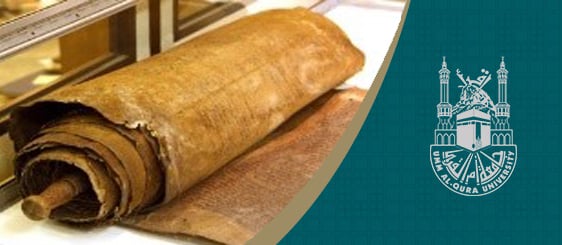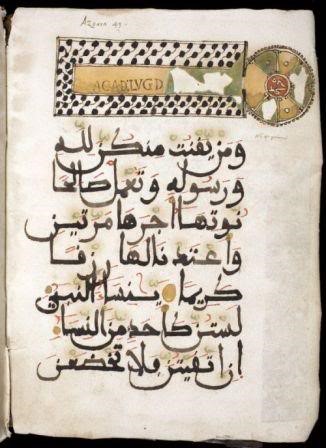Umm Al-Qura University
- Libraries Department


Definition of “Manuscript”: Manuscripts are books that were copied through handwriting by scholars or their students; conveyed by trusted entities from those early copies; or photocopied from original copies.
Value and Significance of Manuscripts: Manuscripts are considered invaluable, precious treasures, as they reveal the knowledge of earlier scholars and their blessed efforts in various sciences; they include reasoning, analyses, collections, writings, translations, etc.
The fourth day of April of each year was designated to celebrate the Arabic Manuscript Day, being corresponding to the establishment of the Institute of Arabic Manuscripts in Cairo about 70 years ago, to be specific in 1946, within the framework of the League of Arab States. The Institute later became affiliated with the Arab League for Education, Culture, and Science Organization (ALECSO) in the early 70s of the last century. The Institute has strong relationships with the Arab and global heritage research centers. It was established with the aim of collecting and indexing Arabic manuscripts, which constitute the greatest heritage of knowledge in the history of mankind, offered by the Islamic civilization to humanity.
Islamic manuscripts come at the forefront in terms of number, variety, and value of content. At the present time, Islamic manuscripts are deemed the most significant written heritage in the world, and perhaps the only heritage that remained substantially preserved, if compared with other heritage in other non-Islamic civilizations whose landmarks have perished.
The recording process started through the sciences of hadith (reports of the words and actions of Prophet Muhammad), as the Arab Islamic authorship movement began, and the approaches to writing branched out in all the different areas of science and knowledge. And it did not take two centuries after the passing away of Messenger Muhammad – peace and blessings be upon him – for the book industry and the copy profession to spread out, and for the book trade to come into existence all over the Islamic world.
One of the most beautiful and most precious Arabic manuscripts is a copy of the Holy Quran that was found in kufic calligraphy with the following script: “This copy of the Holy Quran was written by the Martyr Imam; Possessor of Two Lights; and Prince of Believers, Uthman Ibn Affan – may God be pleased with him – as dictated from the mouths of the companions who used to recite the Quran in his time and who learned it from the Messenger of God – peace and blessings be upon him.” This is in addition to a copy of “بقية الأصمعيات التي أخلت بها المفضليات” or “the remaining poems from Al-Asma’iyyat Anthology that were included within Al-Mufaddaliyyat Anthology,” an anthology of the poetry of Arabs that was transmitted by Al-Asma’i, which goes back to the third century after Hijrah.
There is also a copy of “المعلقات السبع” (The Mu'allaqat) – a collection of seven long Arabic poems – written by Abu Ja’far Ahmad Ibn Muhammad Ibn Ismail Al-Nahhas; this is a very precious copy that was written in the year 338 AH. Furthermore, there is a wooden piece with a carved script of the first verses from the Quranic chapter entitled “Al-Najm” (The Star) in Madani calligraphy (fluid construction) that approximately goes back to the second century after Hijrah.
Germany is considered the only country that sought Arabic manuscripts for the purpose of learning. It re-published, printed, indexed, maintained, and restored many of them. In collecting manuscripts, Germans depended on gifts and purchases, not on seizure. That is because Germany did not have colonial ambitions in the Arab world.
The number of Arabic and Islamic manuscripts kept at German libraries and public and private collections is estimated to be more than 40,000 pieces; most of them are indexed and known by the researchers and scholars who are interested in the study and investigation of heritage.
According to the book “أقدم المخطوطات العربية في مكتبات العالم” (The Oldest Arabic Manuscripts at the World’s Libraries), one of the most prominent manuscripts acquired by Germany is a copy of the book “الجامع الصحيح” (Al-Jami’ Al-Sahih) – a collection of hadith – by Al-Bukhari, which goes back to the year 425 AH. This is in addition to a copy of the book “تاريخ الرسل والملوك” (The History of Messengers and Kings) by Muhammad Ibn Jarir Al-Tabari, which goes to 447 AH, as well as a copy of “ديوان أبي العلاء المعري” (The Collection of Poems by Abu Al-‘Ala’ Al-Ma’arri) that goes back to 475 AH.



Mother Manuscript
A manuscript that was handwritten by the author; this type has no forms. Arab authors used to keep their mother copies at the treasury of Dar Al-Kilafah, for reference, reproduction, and comparison.
Affiliate Manuscript
A manuscript generated from a mother manuscript, and compared to it. It has the same degree of veracity. This too is a manuscript about which there is no doubt.
Vague Manuscript
This can be called a torn or defective manuscript, because it is not good enough to be affiliated with the mother manuscript; there are doubts about its veracity; and it has defects that may cause it to lose the first sheet that contains the title and name of the author. It may also include erasures, inversions, and repetitions. And it may involve corruption in the drawing of letters. In order to correct it, all letters should be analyzed by means of comparison to the original manuscript.
Interval Manuscript
An interval manuscript is one that was written at intervals. The first time, it would be written in a given form. And it would get disseminated among people. After that, the author would add items that were not there in the first stage. There might also be a third copy by the author that would make additions to the previous two stages. An example is the book “وفيات الأعيان لابن خلكان” (The Deaths of Eminent Men by Ibn Khallikan).
Illustrated Manuscript
Illustrated manuscripts are found in many of the studies related to Islamic art. The study of this type of manuscripts requires knowledge and expertise in the matters of illustrations as well as an artistic experience to grasp the artistic touches and written expressions contained in the illustrations.
Manuscripts in the Form of Collections
There are many manuscripts that are listed under the name “collection” or “collections.” A collection is a volume encompassing a number of written works; small pieces; or letters.
Databases That Can Be Useful in This Domain
Maha Bouges – Public Relations – Female Section